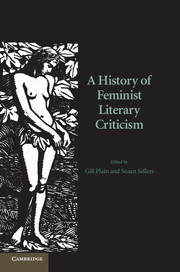Book contents
- Frontmatter
- Contents
- Acknowledgements
- Notes on contributors
- Introduction
- PART I PIONEERS AND PROTOFEMINISM
- Introduction to Part I
- 1 Medieval feminist criticism
- 2 Feminist criticism in the Renaissance and seventeenth century
- 3 Mary Wollstonecraft and her legacy
- 4 The feminist criticism of Virginia Woolf
- 5 Simone de Beauvoir and the demystification of woman
- PART II CREATING A FEMINIST LITERARY CRITICISM
- PART III POSTSTRUCTURALISM AND BEYOND
- Postscript: flaming feminism?
- Index
- References
4 - The feminist criticism of Virginia Woolf
Published online by Cambridge University Press: 05 June 2012
- Frontmatter
- Contents
- Acknowledgements
- Notes on contributors
- Introduction
- PART I PIONEERS AND PROTOFEMINISM
- Introduction to Part I
- 1 Medieval feminist criticism
- 2 Feminist criticism in the Renaissance and seventeenth century
- 3 Mary Wollstonecraft and her legacy
- 4 The feminist criticism of Virginia Woolf
- 5 Simone de Beauvoir and the demystification of woman
- PART II CREATING A FEMINIST LITERARY CRITICISM
- PART III POSTSTRUCTURALISM AND BEYOND
- Postscript: flaming feminism?
- Index
- References
Summary
FEMINIST LITERARY CRITICISM BEFORE WOOLF AND IN WOOLF'S ERA
Virginia Woolf is rightly considered the founder of modern feminist literary criticism. Prior to her landmark contributions to the field, in particular her feminist manifesto of literary criticism, A Room of One's Own (1929), very few works register in historical accounts of its genesis. Catherine Belsey and Jane Moore, in their account of ‘The Story So Far’, point to Esther Sowernam and Bathsua Makin, in the seventeenth century, who identified the presence of powerful female deities and muses in classical literature, and to Mary Wollstonecraft at the end of the eighteenth century, who argued against the infantilising effects on women of sentimental novels, and who also ‘contributed to a feminist anthology of sorts called The Female Reader’ (Belsey and Moore, 1997: 1). As in many received accounts of feminist literary history, anxious to press on to the heady modern period of its flourishing, Belsey and Moore list no one else between Wollstonecraft and Woolf, no one at all alongside Woolf, and no one after Woolf until Simone de Beauvoir (1997: 1). Glenda Norquay's Voices and Votes: A Literary Anthology of the Women's Suffrage Campaign (1995) redresses the critically neglected area of early feminist literature, introducing novels, short stories and poems of the suffrage era (until 1930), an era that spans much of the period of Woolf's formative literary career and closes as A Room of One's Own makes its first impact.
- Type
- Chapter
- Information
- A History of Feminist Literary Criticism , pp. 66 - 84Publisher: Cambridge University PressPrint publication year: 2007
References
- 3
- Cited by



